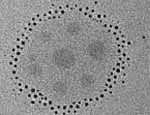

The assembly of nanoparticles into solid assembly structures (so called ‘particle solids’) plays a central role in the integration of nanoparticle systems into device architectures in applications ranging from photovoltaics to solid state lighting. A major barrier in the scalable production of self-assembled particle array structures is the brittle nature of particle solids that promotes crack formation during the processing and integration of particle assembly structures. In this project we test the hypothesis that that the grafting of polymeric ligands (of appropriate architecture) provides a path towards particle solids with significantly enhanced mechanical properties and processibility. The goal is to elucidate the governing parameters that determine the structure and cohesive properties of polymer-grafted particle (also called ‘particle brush’) assemblies and thus contribute to the understanding of the structure-property relations that will enable transformative new fabrication strategies for particle solid materials such as extrusion or roll-to-roll processing. Applications of primary interst encompass photonic films and inks as well as micropatterning of quantum dot array structures.
supported by:
collaboration:
K. Matyjaszewski (Chemistry) S. Margel (Bar-Ilan Univ, IL) CrystalPlex Corp.
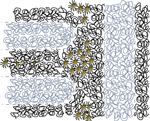
Whereas the study of the equilibrium microstructure formation process contributes important insight into the physics of self-organization of block copolymer/nanoparticle (BCP/NP) composite materials, the ultimate macroscopic properties of the nanocomposite will be related to the defect and grain boundary formation on the microscopic scale. The objective of this project is to understand the implications of nanoscale particle additives on the texture formation as well as the stabilization of grain boundary structures in BCP/NP blends. Our group has been developing a procedure based on film casting under controlled low-pressure conditions, reconstructive electron microscopy of serial images, and stereology-based image analysis to determine the structural parameters that characterize the texture of block copolymer microstructures. Preliminary results point to two primary consequences of particle fillers: (1) the reduction of grain growth during thermal annealing of BCP/NP blends and (2) the stabilization of high-energy grain boundaries by selective swelling of the high-energy grain boundary region by particle fillers.

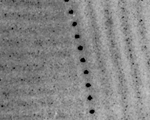
![[110] profile view of gold nanorod](Pictures/Research/Nanorod.gif)
Nanoparticle additives are prime candidates to improve on the properties of thin polymer films that are important in a wide range of technologies ranging from microelectronics to protective coatings and thermal interface materials. The objective of this project is to understand the effect of nanoparticle additives on the thermomechanical and optical characteristics of particle-filled polymer thin films. We are interested in the following questions: (1) what is the effect of attractive enthalpic interactions on the particle miscibility in polymer host materials, (2) what is the effect of the particles’ optical characteristics (i.e. refractive index and volume fraction of core and shell) as well as the particles’ dispersion morphology on the associated optical scattering properties and (3) what is the effect of compatibilized particle additives on the thermomechanical properties of thin polymer films, in particular, how do the thermomechanical properties of polymer nanocomposite thin films depend on the particle architecture. In a related project we are interested in the effect of nanoparticle additives on the linear and nonlinear absorption and scattering characteristics of composite material systems comprising a nonlinear absorbing matrix.
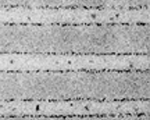
From an application perspectve, research in block copolymer/nanoparticle blend materials has been motivated by the opportunities to engineer novel material functionalities by combining the particular physico-chemical properties of nanoparticle fillers with the microstructure of the copolymer template. In this project we are interested in extending the controlled co-organization of block copolymer blend materials to biologically-derived particle fillers such as enzymes and proteins to faciliate polymer nanocomposite materials with bioactive response that mimic certain property attributes of biological tissue.
The aim of this DTRA-funded project is to understand the implications of polymer-graft modification on the structure formation in block copolymer/enzyme-conjugate blend systems, to understand the parameters that control the organizaiton as well as activity retention of enzyme fillers during film preparation and to evaluate whether the biological response of enzyme-fillers can induce strucutral changes within the copolymer template material.
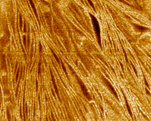
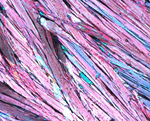
Amphiphilic polymers such as poly(ethylene glycole) are relevant to a wealth of applications ranging from solid ion-conducting materials as electrolytes for fuel cells to bioimplants and drug-release. A common thread in these applications is the idea to take advantage of the coupling between a functional entity (for example an ion or polypeptide) and the polymer and the resulting implications of the coupling on the dynamics and phase stability regions of the resulting composite system.
In this DTRA-funded project we are interested in how the presence of electrolytes affects the structure formation in poly(ethylene glycol) (PEG) and PEG-enzyme conjugates as well as the relevant solvent characteristics that determine the interaction of ions with these systems. For example, using a combination of light and neutron scattering we are investigating the reversible phase separation processes of polymer-PEG conjugates in aquaous solution and the associated implications on peptide bioactivity.
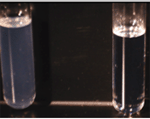
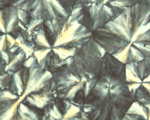
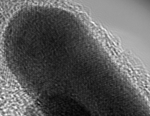
In general, the properties of a composite material with uniform microstructure (e.g. random particle dispersion) can be expected to be a weighted average the properties of its constituent materials. As a consequence the properties of composite materials will typically be 'in between' the respective constituent values. Resonance effects that emerge as a consequence of the particular microstructure of a composite material fundamentally alter the 'rules' that determine composite material properties. For example, resonance effects of light traversing a periodically structured hybrid materials can amplify or alleviate absorption or scattering processes and can be used to engineer hybrid materials with hitherto unattainable property combinations.
In this project we explore the governing parameters that control the propagation of waves (optical and acoustic) through periodically structured polymer-metal and polymer-ceramic composite materials. In a first application of the concept we have been able to demonstrate that the suitable design of periodic metal/polymer composite materials facilitates resonant tunneling of light at absorbing wavelengths thus significantly reducing optical absorption losses in polymer-based metallodielectric composite structures.
supported by:
exploratory
collaboration:
L. Porter (Mat. Sci. & Eng.) G.Fytas (MPI-P, Germany)
